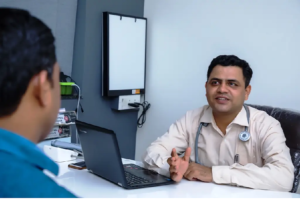Optimizing Recovery After Spinal Disc Replacement
5 min read
Recovering from spinal disc replacement surgery involves several stages, each requiring patience, proper care and a clear understanding of what to expect. While the procedure offers potential benefits, such as pain relief and improved mobility, navigating the recovery process carefully may help maximize these outcomes. Dr. Larry Davidson, a leading expert in spinal surgery, highlights the importance of recovery after a procedure.We will look into the post-surgery recovery phases, practical tips for managing pain and what patients can expect on their journey to resume normal activities.
The Initial Recovery Phase: Hospital Stay and Early Mobilization
Immediately following spinal disc replacement surgery, patients typically stay in the hospital for one to three days. During this time, medical staff closely monitor vital signs, mobility and any signs of complications, such as infection or excessive bleeding. Pain management is often a primary focus and patients may receive medications to manage pain and reduce inflammation.
Early mobilization is generally encouraged, as gentle movement may help reduce the risk of complications like blood clots and support circulation. Patients are typically advised to start with short, supported walks around the hospital room, gradually increasing their movement as tolerated. It’s essential to follow medical advice closely during this period, as pushing too hard can delay recovery. Walking with assistance and taking breaks helps prevent strain on the newly implanted disc, setting a foundation for the next stages of recovery.
The First Few Weeks: Building Strength and Managing Pain at Home
Upon discharge, patients continue their recovery at home, focusing on basic self-care and gradually building strength. During these initial weeks, it’s crucial to manage pain effectively while allowing the body to heal. Pain management strategies may include prescribed medications, over-the-counter options and ice packs applied to reduce inflammation and soothe the surgical area.
Patients should avoid bending, twisting or lifting heavy objects during this time, as these movements can strain the spine. Rest and gentle movements, like short walks, help maintain mobility without stressing the surgical site. I Listening to one’s body and avoiding pushing through pain may help minimize setbacks. Additionally, keeping an upright posture and using supportive seating can relieve pressure on the spine, aiding in a smoother recovery.
Physical Therapy and Rehabilitation: The Path to Restored Mobility
Many patients begin physical therapy around four to six weeks after surgery under the guidance of a licensed therapist. Physical therapy can play an important role in supporting muscle strength, flexibility and stability around the spine. Initially, therapy focuses on gentle exercises, such as pelvic tilts, knee-to-chest stretches and core-strengthening routines designed to support spinal alignment without overloading the new disc.
Progress in physical therapy is gradual, with exercises becoming more intensive as the patient’s strength improves. A key aspect of this phase is adhering to the therapist’s instructions and avoiding high-impact activities or excessive twisting movements, which could compromise the implant. Patients should also continue to manage pain as needed, using methods like heat or cold therapy and practicing deep breathing exercises to promote relaxation and pain relief.
Managing Pain Throughout Recovery
Effective pain management is important in supporting a smoother recovery. Patients should work closely with their healthcare provider to create a tailored pain management plan that may include both medications and non-pharmacological methods. For instance, alternating between ice and heat therapy can help manage pain and stiffness, especially after physical therapy sessions.
Gentle stretching, mindfulness and relaxation exercises, such as yoga or meditation, can also support pain management by helping to reduce muscle tension and improve mental well-being. It’s essential to avoid over-reliance on pain medications, particularly opioids, as these carry the risk of dependence. Instead, focusing on a balanced approach that includes lifestyle modifications, physical therapy and proper rest can be highly effective.
The Role of Lifestyle Adjustments in Supporting Long-Term Recovery
Long-term recovery and the success of spinal disc replacement rely not only on post-surgery rehabilitation but also on adopting a spine-friendly lifestyle. Maintaining a healthy weight may help reduce stress on the spine, potentially supporting the durability of the artificial disc. Regular low-impact exercises, such as swimming, walking and stationary cycling, help keep the spine flexible and strong without placing undue strain on the implant.
Core strengthening is particularly beneficial, as it provides additional support to the spine and helps prevent future injury. Patients are advised to avoid high-impact activities, like running or heavy lifting unless cleared by their healthcare provider. Embracing ergonomic practices in daily life, such as using supportive chairs, proper lifting techniques and adjusting workspace setups, can also help prevent unnecessary strain on the spine.
Realistic Expectations and Milestones in the Recovery Timeline
Recovery from spinal disc replacement varies from patient to patient, but there are general milestones that can help guide expectations. In the first few months, most patients experience gradual improvements in pain and mobility. By six months, many individuals may be able to return to light activities and daily routines with minimal discomfort. However, full recovery—where patients feel entirely comfortable resuming normal activities—can take up to a year.
It’s essential to approach recovery with patience, as setbacks can occur. Pain levels may fluctuate, and some days may be more challenging than others. Maintaining realistic expectations and celebrating small improvements can keep motivation high. Support from healthcare providers, physical therapists and loved ones can also encourage this journey.
When to Seek Medical Advice
Although recovery typically proceeds without major issues, it’s crucial to stay vigilant for signs that may require medical attention. Symptoms such as severe pain, fever, numbness, weakness in the legs or any signs of infection around the surgical site should prompt a consultation with a healthcare provider. Early intervention for any complications can help prevent further issues and ensure that recovery stays on track.
Navigating recovery after spinal disc replacement involves a combination of rest, gradual physical therapy, effective pain management and lifestyle adjustments. Each recovery phase offers its challenges and milestones, with improvements in mobility and comfort as guiding signs of progress. Dr. Larry Davidson emphasizes that by setting realistic expectations, following medical advice and maintaining a proactive approach to self-care, patients may experience a smoother recovery and work toward an active, more comfortable future.





